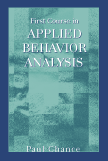"I used this for many years until I retired. It`s excellent as a basic nuts and bolts introduction." —Paul Brandon, Minnesota State University, Mankato
"I think First Course is a great introduction to the field. It is the right blend of great writing, enthusiasm for behavior analysis, and fun reading. Students love the fictional class and its characters. I've used the text for many years." —David L. Morgan, Spalding University
"The text is a great way for the students to digest the essentials of ABA. They seem to enjoy the book, and I like teaching from it."—Jenna Holt, Mary Baldwin College
"The book is extremely readable without sacrificing accuracy." —Elizabeth Street, Central Washington University
"I particularly appreciate the conversational style of writing." —Cam L. Melville, McNeese State University
“A beautifully written introduction to behavior analysis! These are the discussions from which my students could so greatly benefit. Chance has written them out in an informative and comprehensible manner.” — Lee Mason, University of Texas at San Antonio

485 pages, $77.95 list
1-57766-472-8
978-1-57766-472-7
© 1998
paperback
Instructor's resource materials available here
To obtain a username and password to access instructor's materials, contact comps@waveland.com.
To obtain a username and password to access instructor's materials, contact comps@waveland.com.
Similar Titles
Also by
Paul Chance
Paul Chance
First Course in Applied Behavior Analysis
In this creative, engaging approach to behavior analysis, written in clear, jargon-free language, Chance blends realistic examples with research and case studies. His main goals are for readers to learn the language of behavior analysis, to become acquainted with the most important procedures for changing behavior, and to recognize that scientific method can be used successfully to solve problems. He has created an interactive classroom experience to facilitate the learning and application of practical solutions to behavior problems. In a simulated classroom, course content is presented by Dr. Cee—a fictional instructor whose lectures are punctuated by frequent questions designed to keep readers on their toes and to think critically about a particular topic. This authoritative yet comprehensible text is written primarily for students taking an introductory course in applied behavior analysis but is readable enough to be profitable to parents, teachers, counselors, psychologists, therapists, and social workers.
Reactions
Reprinted pieces include:
A Behaviorist’s Feelings (B. F. Skinner) • The Queen’s Scepter (Eric Haughton & Teodoro Ayllon) • The Rewards of Coaching (Hilary Buzas & Teodoro Ayllon) • Rules to Live By (B. F. Skinner) • Shaping Sight (Judith R. Mathews, Gary D. Hodson, William B. Christ, & G. Robert LaRoche) • Chained Routine (Melvyn Hollander & Vivian Horner) • Extinguished Tears (Carl D. Williams) • Exorcising a Witch (Brad A. Alford) • Time Out for Hallucinations (Steve N. Haynes & Pamela Geddy) • Attention (B. F. Skinner) • A Technology of Generalization (Trevor F. Stokes & Donald M. Baer) • Novel Maintenance (Irving Wallace) • Old Obsessions (John E. Calamari, Samantha D. Faber, Brian L. Hitsman, & Christopher J. Poppe) • Right to Effective Treatment (Ron Van Houten and the Task Force on the Right to Effective Treatment)
I. INTRODUCTION
1. The ABCs of Applied Behavior Analysis
2. Methods in Applied Behavior Analysis
II. INCREASING THE FREQUENCY OF BEHAVIOR
3. Reinforcement
4. Prompting and Fading
5. Shaping and Chaining
III. DECREASING THE FREQUENCY OF BEHAVIOR
6. Extinction and Differential Reinforcement
7. Punishment
IV. ESTABLISHING DISCRIMINATIONS
8. Discrimination Training
V. GENERALIZATION AND MAINTENANCE
9. Generalization Training
10. Maintenance
VI. MODIFYING RESPONDENT BEHAVIOR
11. Counterconditioning
VII. ETHICS AND THE FUTURE
12. The Ethics of Behavior Change and the Future of Behavior Analysis
VIII. REVIEW
13. Review and Sham Exam
Glossary
A Behaviorist’s Feelings (B. F. Skinner) • The Queen’s Scepter (Eric Haughton & Teodoro Ayllon) • The Rewards of Coaching (Hilary Buzas & Teodoro Ayllon) • Rules to Live By (B. F. Skinner) • Shaping Sight (Judith R. Mathews, Gary D. Hodson, William B. Christ, & G. Robert LaRoche) • Chained Routine (Melvyn Hollander & Vivian Horner) • Extinguished Tears (Carl D. Williams) • Exorcising a Witch (Brad A. Alford) • Time Out for Hallucinations (Steve N. Haynes & Pamela Geddy) • Attention (B. F. Skinner) • A Technology of Generalization (Trevor F. Stokes & Donald M. Baer) • Novel Maintenance (Irving Wallace) • Old Obsessions (John E. Calamari, Samantha D. Faber, Brian L. Hitsman, & Christopher J. Poppe) • Right to Effective Treatment (Ron Van Houten and the Task Force on the Right to Effective Treatment)
I. INTRODUCTION
1. The ABCs of Applied Behavior Analysis
2. Methods in Applied Behavior Analysis
II. INCREASING THE FREQUENCY OF BEHAVIOR
3. Reinforcement
4. Prompting and Fading
5. Shaping and Chaining
III. DECREASING THE FREQUENCY OF BEHAVIOR
6. Extinction and Differential Reinforcement
7. Punishment
IV. ESTABLISHING DISCRIMINATIONS
8. Discrimination Training
V. GENERALIZATION AND MAINTENANCE
9. Generalization Training
10. Maintenance
VI. MODIFYING RESPONDENT BEHAVIOR
11. Counterconditioning
VII. ETHICS AND THE FUTURE
12. The Ethics of Behavior Change and the Future of Behavior Analysis
VIII. REVIEW
13. Review and Sham Exam
Glossary